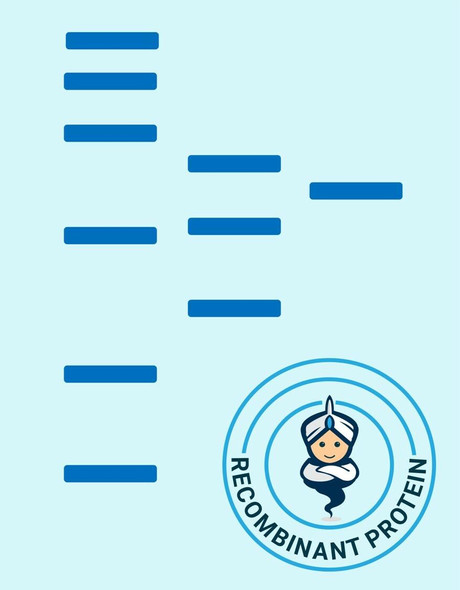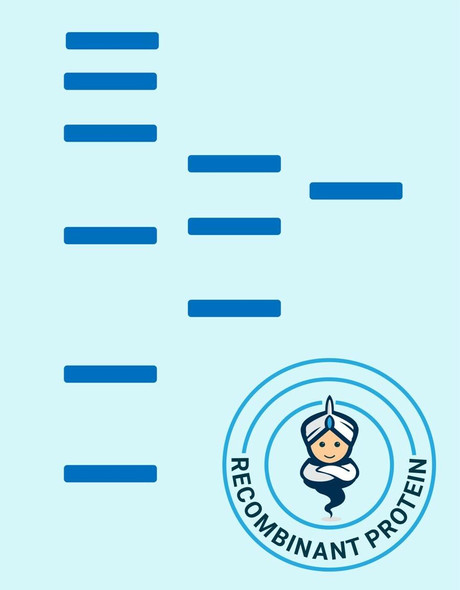Chemokines Recombinant Proteins
Human MIP 1b Recombinant Protein (RPPB1217)
- SKU:
- RPPB1217
- Product Type:
- Recombinant Protein
- Species:
- Human
- Uniprot:
- P13236
- Research Area:
- Chemokines
Description
| Product Name: | Human MIP 1b Recombinant Protein |
| Product Code: | RPPB1217 |
| Size: | 10µg |
| Species: | Human |
| Target: | MIP 1b |
| Synonyms: | Small inducible cytokine A4, CCL4, Macrophage inflammatory protein 1-beta, MIP-1- beta, MIP-1-beta(1-69), T-cell activation protein 2, ACT-2, PAT 744, H400, SIS-gamma, Lymphocyte activation gene 1 protein, LAG-1, HC21, G-26 T-lymphocyte-secreted protein, chemokine (C-C motif) ligand 4, ACT2, G-26, LAG1, MIP1B, SCYA4, AT744.1, MGC104418, MGC126025, MGC126026. |
| Source: | Escherichia Coli |
| Physical Appearance: | Sterile Filtered White lyophilized (freeze-dried) powder. |
| Formulation: | Lyophilized from a concentrated (1mg/ml) solution in water containing no additives. |
| Solubility: | It is recommended to reconstitute the lyophilized Macrophage Inflammatory Protein-1b in sterile 18M?-cm H2O not less than 100�g/ml, which can then be further diluted to other aqueous solutions. |
| Stability: | Lyophilized MIP-1b although stable at room temperature for 3 weeks, should be stored desiccated below -18°C. Upon reconstitution CCL4 should be stored at 4°C between 2-7 days and for future use below -18°C. For long term storage it is recommended to add a carrier protein (0.1% HSA or BSA).Please prevent freeze-thaw cycles. |
| Purity: | Greater than 99.0% as determined by:(a) Analysis by RP-HPLC.(b) Analysis by SDS-PAGE. |
| Amino Acid Sequence: | The sequence of the first five N-terminal amino acids was determined and was found to be, Ala-Pro-Met-Gly-Ser |
| Biological Activity: | The Activity is calculated by the ability to chemoattract Human blood monocytes using a concentration of 5-20ng/ml corresponding to a Specific Activity of 50,000-200,000IU/mg. |
Macrophage Inflammatory Proteins belong to the family of chemotactic cytokines known as chemokines. In humans, there are two major forms, MIP-1a and MIP-1b that are now also named CCL3 and CCL4. Both factors are produced by macrophages after they are stimulated with bacterial endotoxins. MIP-1a and MIP-1b activate human granulocytes (neutrophils, eosinophils and basophils) which can lead to acute neutrophilic inflammation. MIP-1a and MIP-1b induce synthesis and release of other pro-inflammatory cytokines such as interleukin-1 (IL-1), IL-6 and TNF-alpha from fibroblasts and macrophages. CCL3 and CCL4 genes are both located on human chromosome 17.
Macrophage Inflammatory Protein-1 beta Human Recombinant produced in E.Coli is a single, non-glycosylated, polypeptide chain containing 69 amino acids and having a molecular mass of 7620 Dalton. The CCL4 is purified by proprietary chromatographic techniques.
| UniProt Protein Function: | CCL4: Monokine with inflammatory and chemokinetic properties. Binds to CCR5. One of the major HIV-suppressive factors produced by CD8+ T-cells. Recombinant MIP-1-beta induces a dose-dependent inhibition of different strains of HIV-1, HIV-2, and simian immunodeficiency virus (SIV). The processed form MIP-1-beta(3-69) retains the abilities to induce down-modulation of surface expression of the chemokine receptor CCR5 and to inhibit the CCR5- mediated entry of HIV-1 in T-cells. MIP-1-beta(3-69) is also a ligand for CCR1 and CCR2 isoform B. Belongs to the intercrine beta (chemokine CC) family. |
| UniProt Protein Details: | Protein type:Secreted; Secreted, signal peptide; Motility/polarity/chemotaxis; Chemokine Chromosomal Location of Human Ortholog: 17q12 Cellular Component: extracellular space; extracellular region Molecular Function:identical protein binding; protein binding; CCR1 chemokine receptor binding; chemokine activity; cytokine activity; CCR5 chemokine receptor binding Biological Process: cell-cell signaling; response to toxin; response to virus; establishment and/or maintenance of cell polarity; positive regulation of calcium-mediated signaling; immune response; positive regulation of calcium ion transport; inflammatory response; cell motility; signal transduction; cell adhesion |
| NCBI Summary: | The protein encoded by this gene is a mitogen-inducible monokine and is one of the major HIV-suppressive factors produced by CD8+ T-cells. The encoded protein is secreted and has chemokinetic and inflammatory functions. [provided by RefSeq, Dec 2012] |
| UniProt Code: | P13236 |
| NCBI GenInfo Identifier: | 127080 |
| NCBI Gene ID: | 6351 |
| NCBI Accession: | P13236.1 |
| UniProt Secondary Accession: | P13236,P22617, Q13704, Q3SXL8, Q6FGI8, |
| UniProt Related Accession: | P13236 |
| Molecular Weight: | 92 |
| NCBI Full Name: | C-C motif chemokine 4 |
| NCBI Synonym Full Names: | chemokine (C-C motif) ligand 4 |
| NCBI Official Symbol: | CCL4�� |
| NCBI Official Synonym Symbols: | ACT2; G-26; HC21; LAG1; LAG-1; MIP1B; SCYA2; SCYA4; MIP1B1; AT744.1; MIP-1-beta�� |
| NCBI Protein Information: | C-C motif chemokine 4; PAT 744; SIS-gamma; MIP-1-beta(1-69); secreted protein G-26; T-cell activation protein 2; G-26 T-lymphocyte-secreted protein; lymphocyte activation gene 1 protein; macrophage inflammatory protein 1-beta; small inducible cytokine A4 |
| UniProt Protein Name: | C-C motif chemokine 4 |
| UniProt Synonym Protein Names: | G-26 T-lymphocyte-secreted protein; HC21; Lymphocyte activation gene 1 protein; LAG-1; MIP-1-beta(1-69); Macrophage inflammatory protein 1-beta; MIP-1-beta; PAT 744; Protein H400; SIS-gamma; Small-inducible cytokine A4; T-cell activation protein 2; ACT-2 |
| Protein Family: | C-C motif chemokine |
| UniProt Gene Name: | CCL4�� |
| UniProt Entry Name: | CCL4_HUMAN |






